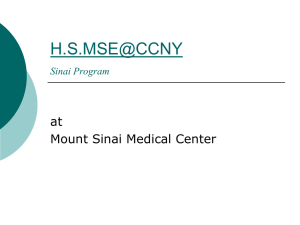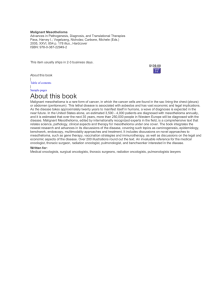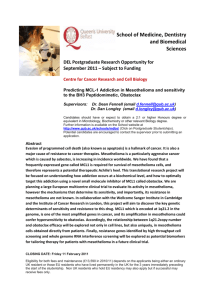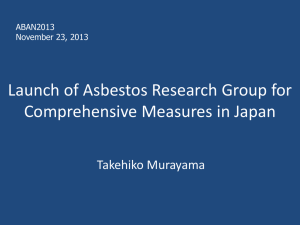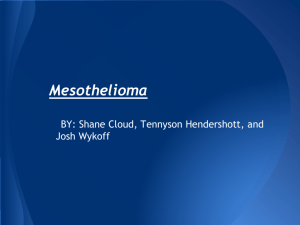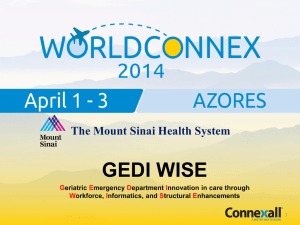Occupational Safety and Health
advertisement
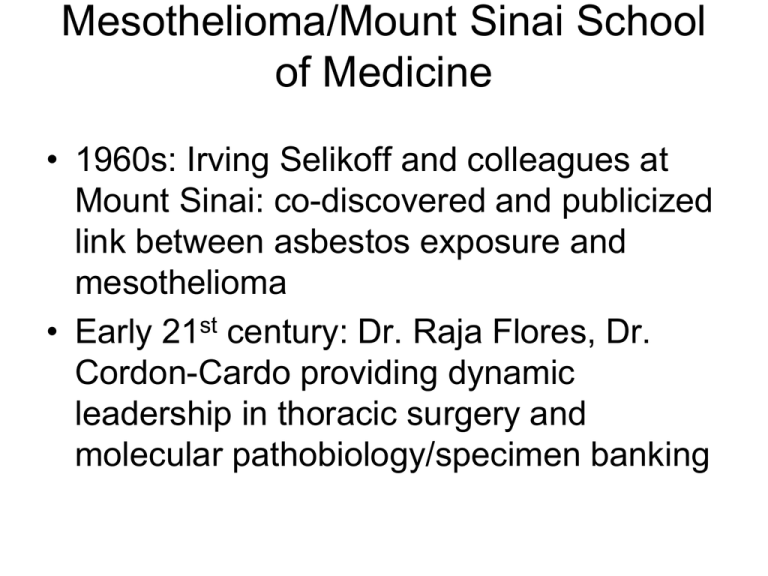
Mesothelioma/Mount Sinai School of Medicine • 1960s: Irving Selikoff and colleagues at Mount Sinai: co-discovered and publicized link between asbestos exposure and mesothelioma • Early 21st century: Dr. Raja Flores, Dr. Cordon-Cardo providing dynamic leadership in thoracic surgery and molecular pathobiology/specimen banking Selikoff Occupational Safety and Health WIKIPEDIA: In the 1960s Selikoff documented asbestos-related diseases among industrial workers. He found that workers exposed to asbestos often had scarred lung tissue 30 years after exposure. His research is credited with having pressured the Occupational Safety and Health Administration (OSHA) to limit workplace exposure to asbestos.[2] Selikoff In the 1950s, Selikoff had opened a general-medicine practice called the Paterson Clinic in Paterson, NJ. A few years later, the Asbestos Workers Union asked him to add their membership to his practice. He agreed, and business picked up noticeably. In a few years, however, Selikoff noticed surprising events; several new cases of mesothelioma were diagnosed in a year—the expected incidence was about 5/100,000. (The new cohort (asbestos workers) were still a small fraction of the clinic's patient list, but this small group faced grave and novel risks.) Selikoff This anomaly led Selikoff into an examination of the relation between asbestos exposure and mesothelioma. He became aware of hundreds of articles previously published on this issue. He engaged in additional studies of groups of asbestos workers, in particular shipyard workers including those at the Long Beach Naval Shipyard. By 1965, he had conducted various studies, published several articles, conducted special scientific symposia, and been interviewed by the New York Times. Each of these raised public awareness of the issue, which had been known to the occupational health community but which had not yet reached widespread public awareness Mt Sinai • Twenty top funded medical institutions, most rapidly growing in research funding in NY Area. • Renowned in environmental medicine • Dynamic thoracic surgery division • Drs. S. Levin and A. Todd: close relationship with International Association of Heat and Frost Insulators and Allied Workers (IAHFIAW): asbestos exposure • World-class team of interventional thoracic radiologists • Active and expanding specimen biorepository Commitment to NMVB • Mesothelioma resections/year at Mount Sinai: 30 • Commitment includes contributing specimens for any Letter of Intent approved by NMVB’s Research Evaluation Panel Commitment to NMVB • Within 2 months of notification of funded participation in NMVB, we received approval from Mt. Sinai’s IRB • First patient identified this week who will participate in the program. • NMVB protocols are in alignment with Mt. Sinai’s biorepository protocols for tumor tissue banking. Mission The Cancer Institute Biorepository is a shared resource administered directly by the Tisch Cancer Institute which provides an extensive biospecimen resource with associated clinical data in order to facilitate translational research for Mount Sinai investigators and collaborators. The highest quality annotated collections provide a platform for translational research that can lead to improved diagnosis and care of cancer patients. Services/ Process Flow • • • • • • • • Coordinate patient consent for donation of specimens Coordinate timely processing, annotation and storage of specimens Collect pre-and post-surgical blood samples and process into serum, plasma and peripheral blood leukocyte fractions Collect urine samples for specific projects Perform histologic staining and pathology review of tissue specimens, using mirror image samples adjacent to frozen samples. Oversee regulatory compliance: IRB, HIPAA, NY State Dept. of Health; best practice methods for safe processing and usage of specimens Oversee quality assurance, both for integrity of specimens and reliability of clinical data Maintain utilization committee to perform regulatory and scientific review of, and prioritize requests for, specimen-related projects Radiology ( GE IDXRAD Laboratory ) ( SCC Pathology ) ( TAMTRON External ) Lab ( QUEST Caregiver ) External Master Credential Code Sets ( ICD 9 , CPT Access Management ( CERNER 4 etc .) ) Inpatient CPOE ( Eclipsys Discharge Team ) Assignment Discharge Planning & Summary Operative Report Mount Sinai Data Warehouse Outpatient CIS ( EPIC ) Surgery Chemotherapy ED CIS ( IBEX ) (EAGLE Clinical and Case Billing ) Financial Management ( CANOPY ) Decision Support System Heme/Onc Radiation Oncology & Staffing William K. Oh, MD, Medical Director David E. Burstein MD, Pathology Co-Director Carlos Cordon-Cardo, MD, PhD, Pathology Co-Director Administrative Director: TBN Maria Saravia: Tissue procurement and consenting Tricia Ali-Shaw: Tissue procurement and consenting Camelia Iancu-Rubin, Program Coordination, Heme Boris Rudoy, IT programmer Equipment • Three -80 degree Revco freezers with emergency power backup • Five 50 gallon liquid nitrogen tanks • Freezers located in the basements of Atran and Guggenheim Pavilions • Sample processing located on Annenberg 15 and 24 Representative Projects Specimen Type Lung cancer, frozen N PI Primary and metastatic carcinoid, frozen Melanoma, frozen 19 D Zhang HCC 15 E Bernstein CMT Soft tissue sarcomas, frozen 18 S Aaronson CMT MPN, blood, aspirates 89 R Hoffman MMP MPN, blood, aspirates 34 M Xu MMP 132 S Aaronson CMT Findings and outcome “Wnt activation predicts worse prognosis in Stage 1 lung cancer” led to platform presentation, 2010 American Assoc. of Thoracic Surgery by collaborator, C Chin “Differential protein expression in small intestinal carcinoids and liver metastases” led to presentation, 2010 North American Neuroendocrine Tumor Society Resulted in K12 award to collaborator, M Kim. Publication: Kapoor A et al. “The histone variant macroH2A suppresses melanoma progression through regulation of CDK8, Nature 2010, 468:1105-9.” Contributed to RO1 renewal Publication: Vijayakumar S et al. “High-frequency canonical Wnt activation in multiple sarcoma subtypes drives proliferation through a TCF/β-catenin target gene, CDC25a.” Cancer Cell 2011, 19:60112. “Use of stem cells derived from the chromosome-negative myeloproliferative disorders as a chemotherapeutic target” Funded by MPD Foundation Multiple publications Contributed to NY State Stem Cell grant, awarded “Rational use of combinations of chemotherapeutic agents for the treatment of myeloproliferative disorders” Funding: Leukemia and Lymphoma Society Contributed to RO1 grant, awarded Recent research • Mutat Res. 2011 Aug 16;723(2):171-6. Epub 2011 May 6. • Crocidolite asbestos-induced signal pathway dysregulation in mesothelial cells. • Wang H, Gillis A, Zhao C, Lee E, Wu J, Zhang F, Ye F, Zhang DY. Recent research • Cancer Res. 2005 Apr 1;65(7):2602-9. • Evidence against a role for SV40 in human mesothelioma. • Manfredi JJ, Dong J, Liu WJ, Resnick-Silverman L, Qiao R, Chahinian P, Saric M, Gibbs AR, Phillips JI, Murray J, Axten CW, Nolan RP, Aaronson SA. • Source • Department of Oncological Sciences, Mount Sinai School of Medicine, New York, New York, USA. Recent research • Am J Ind Med. 2008 Nov;51(11):877-80. • Environmental exposure to Libby Asbestos and mesotheliomas. • Whitehouse AC, Black CB, Heppe MS, Ruckdeschel J, Levin SM. Publications • Surgical treatment of malignant pleural mesothelioma. • Kaufman AJ, Flores RM. • Curr Treat Options Oncol. 2011 Jun;12(2):201-16. Publications • Clin Chem Lab Med. 2010 Feb;48(2):271-8. • Soluble mesothelin related peptides (SMRP) and osteopontin as protein biomarkers for malignant mesothelioma: analytical validation of ELISA based assays and characterization at mRNA and protein levels. • Rai AJ, Flores RM, Mathew A, GonzalezEspinoza R, Bott M, Ladanyi M, Rusch V, Fleisher M.
